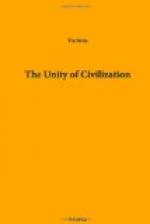Whatever Greek statesmen thought about the gulf between Greek and Persian, or Greek and Barbarian generally, Greek ethnologists raised no fundamental barrier between the different sorts of Man. Good naturalists as they were, and experienced breeders of farm-stock, they accepted white, brown, and black men; and were prepared to accept any other breed that Nearchus or Pytheas might confront them with, as members of one brotherhood, just as they accepted white, brown, or black sheep, with horns of Ammon or with none. Eratosthenes, most philosophical, and therewith most political of them all, was bred in Cyrene, where some Greeks seem to have been black; and he worked in Alexandria, where the University was a human Zoo like that of London or Berlin. Their simple farmer’s theory of natural selection attributed ‘scorched-faced’ Aethiopians to sunburn, and other racial types to large factors of region and regime. The classical treatise is that of Hippocrates ’On Air, Water, and Places’.[3]
In the modern world, too, no serious doubt was cast on the specific unity of mankind, handed down from antiquity, until Linnaeus and Buffon had refined upon the biological notions of genus and species (for both of which there is only one word in Greek), and had defined species by the criterion of fertility. Now not only the great explorers, but every ship’s captain, knew by this time that white men, at all events, would form fertile unions with all known kinds of humanity. But in the eighteenth century it became known also, and in the same empirical way, that the fertility of unions between white men and black was imperfect; and as this was the only human cross for which there was any large quantity of evidence, the impression grew that the zoological distance between these races was greater than had been supposed. On the other hand, eighteenth-century formulators of the ‘Rights of Man’ challenged reconsideration of the current practice of negro slavery; and the upshot was a controversy. Abolitionists contended that the ‘black brother’ was indeed a blood brother, and entitled to the ‘Rights of Man’; their opponents replied that the negro, being (as they held) of another species, might justly be treated in all respects as one of white man’s domestic animals, and be his property as well as his drudge. At the turn of the century, the adherence of Cuvier gave prestige to Polygenesis on its scientific side: and it took all the reasonableness of Prichard in the next generation to turn the tide even in England. But the issue of the American Civil War, to which reference has already been made, coincided so closely in time with the work of Darwin and Lyell on the real meaning of species and on the antiquity of man, that the controversy was closed without bitterness. The new phase of Polygenism which seems now to be opening, with successive discoveries of the quaternary stratification of races, and Keith’s analysis of the family tree of the Hominidae, starts from wholly different data, unembarrassed by fears or hopes of a ‘Neanderthal’ origin for the Negro, or for any living or recent Homo.




